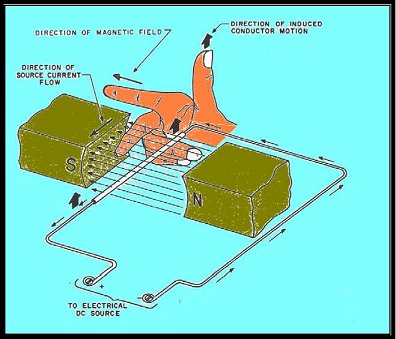Mechanical Motion From Electrical Energy
If a current carrying wire is placed in another magnetic field, magnetic forces are produced to either attract or repel wire depending on direction of two fields.
The lines of force can be compared to elastic bands, which stretch outward when a force is exerted upon them and contract when the force is removed.
Characteristics of magnetic lines of force:
a. Magnetic lines of force pass through all materials, there is no insulator against them.
b. Each magnetic line forms a closed loop. Its direction is externally from the North Pole to the South Pole.
c. Magnetic lines of force do not cross each other
d. Magnetic lines of force tend to shorten themselves
Laws of attraction and repulsion
a. Two unlike poles North and South will attract each other if brought together
b. Two like poles, North and North, or South and south will repel each other if brought together. Note that lines of force traveling in the same direction cause repulsion.
c. The force between two magnets decreases rapidly with the distance of separation.
d. The rule, which relates the direction of magnetic field and conventional current flow, shown in figure 1.1, is known as the Right Hand Rule.
Fig.1-1.Application of the right hand rule
The magnetic fields around conductors interact to produce forces of attraction or repulsion as shown on Fig.1-2.
Fig.1-2.Forces of interaction between current carrying conductors
The lines of force flowing in opposite direction produce force of attraction, while lines of force flowing in the same direction produce repulsion.
The principle of motor operation is shown in Fig.1-3.
Diagram 1.3a current is flowing in the coil thus no flux is produced and no torque is present no motion.
Diagram 1.3b Current is passing through the coil, the flux produced causes repulsion force (same direction of lines of force). The coil rotates.
Diagram 1.3c No torque since the coil is not being pushed from or propelled out of the field. No cutting of lines of force.
Fig.1-3d.The motor principle
Diagram 1.3d the coil is rotated by 180 ° from original position, for the motor to
continue to rotate in the same direction; the supply voltage must be reversed.
An AC supply or a commentator can do this.








"The working of motor is based on the principle that whenever a __current carrying conductor___ is placed in a magnetic field it experiences a force in the direction as shown by flemings left hand rule."
ReplyDeleteexplain...do we really have a conductor carrying current(rotor) placed in the magnetic field? as per your explanation?
hi noura welcome in my small blog
ReplyDeleteof course we have a conductor but in a magnetic field
which coming from the Magnet
when the current flows in the coil the coil in presence
of the magnetic field it generate the force
Electrical energy is the result of the interaction of subatomic particles with electromagnetic force. Within an atom, electrons and protons create a charge. This charge can be transferred between bodies using direct contact with a conductive material like a wire.
ReplyDeleteattention for all
ReplyDeletethis course is belong SWCC in saudi arabia training centre and this persone is stall this course from us and I have the orginal copy for any contact pls send email to famhg@hotmail.com
Regards,
There is no attraction force between opposite direction lines of force. The force on a current carrying wire in a magnetic field is caused by the repulsion of same direction flux.
ReplyDeleteIf there was attraction between opposite direction flux, the attraction force (opposite direction flux) would cancel the repulsion force (same direction flux) and there would be no resultant force. We all know there is a strong resultant force caused by the repulsion of same direction flux (the Lorentz/Laplace force) therefor there is little if any force between opposite direction flux. lawrencesprung@yahoo.com